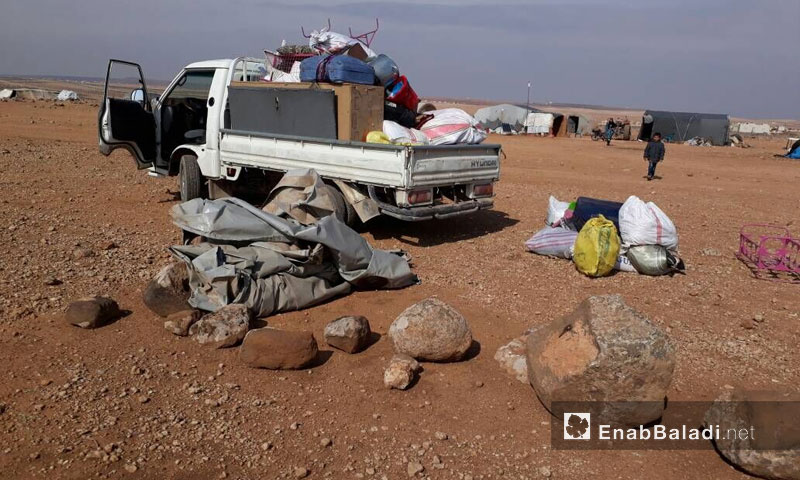In the open air, hundreds of families displaced from the towns and villages of Hama’s eastern countryside found only the roads to take as a shelter after they left their regions due to the heavy shelling by the Syrian and Russian airplanes.
The region was under hundreds of aerial attacks, which claimed that the ‘Islamic State’ Organization (IS) was the target. They resulted in a sufficient damage in residential buildings and caused dozens of deaths and injuries, mostly children and women. All this happened despite the fact that Hama’s countryside has joined the de-escalation agreement along with Idlib and parts of Aleppo and Lattakia, which was agreed upon by the grantor countries of Turkey, Russia and Iran on 15 September.
The Displaced People’s Conditions are Tragic
In a statement issued on Thursday, October 26, the Free Hama Provincial Council, under the Syrian Interim Government, demanded a commitment to the de-escalation agreement and called on the international committees and human rights organizations to abide by their obligations and “to pressure criminals to stop their crimes against civilians east of Hama.”
About the displaced people’s conditions, Khaled El Hoyan, a member of the provincial council, told Enab Baladi that “their situation is difficult and tragic.” Several families live in one tent, and sometimes 15 families live in a house with only two rooms; others live in the open under their vehicles or water tanks.
According to El Hoyan, the displaced people are from the following villages: “Sabura, Enek, Sarha, Rajhan, Qasr Ibn Wardan, al-Janin, Hamra, Arafah.”
The number of the displaced people, he said, is more than 4320, who came to the city of Idlib and its countryside and that the Free Hama Provincial Council is working to prepare a camp in Sinjar’s southern countryside.
Mohammed Abu al-Baraa, an activist, confirmed that the villages of Hama’s eastern countryside, 100 towns and villages, are devastated and empty.
Abu al-Baraa said that the displaced people, escaping the shelling, went through the whole of Hama’s eastern countryside on foot going to Idlib, “as if they were borders between one country and another.”
He considers that “an unknown future awaits the displaced people of Hama’s countryside. [They are stuck] between displacement, sickness, disability and a death controlling their fate in the shadow of the absence of a solution or project to come up with a considerate solution.”
One Bakery Is Not Enough for Thousands of People
Due to the large numbers, the regions and the camps, to which the displaced civilians of Hama’s countryside went to, are facing an intricate pressure.
Abu al-Baraa clarified the situation and said that the suffering in the camps increased with the increasing spate of displacement which inflated the pressure relating to the provision of civilians’ basic needs, bread on a specific term. In Sinjar, there is only one bakery which bakes eight tons a day. The amount is not enough for the families, who were already in the region, and with the arrival of thousands of displaced people, it became a necessity to find a solution, considering that the numbers of the displaced people are increasing on a daily basis.
Winter made displacement harder for it boosted the daily suffering of the people, which manifests in the attempt to provide food for their children and to find a shelter to protect them from cold and rain, especially with the absence of humanitarian organizations in the region, according to El Hoyan.
These organizations, he said, are plying a minimal role. In Hama’s eastern countryside, especially in the area of Saraqib and its surrounding areas, little has been provided to the displaced people.
Both activists and displaced people are calling on international organizations to immediately intervene and provide humanitarian and food aid, especially milk for babies, to thousands of families in the area.

